Ryan Hall's Blog, page 312
December 10, 2015
Strength Training for Runners: The Walking Lunge
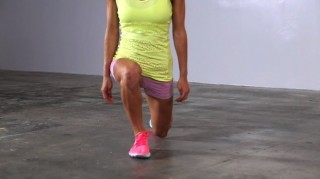
A classic bodyweight strength training exercise, here’s how to do the walking lunge properly.
RELATED: Video: The Raised Hamstring Stretch
The post Strength Training for Runners: The Walking Lunge appeared first on Competitor.com.
Out There: Recalculating Your Route

Photo: Shutterstock.com
“In 800 meters, turn left.”
I slowed the car to a crawl, looking to the left for the third time. Just like the previous drive-bys in the last five minutes, there was no place to turn off the main road.
“In 300 meters, turn left,” the voice in the GPS unit prompted once again. “Turn left.”
“I can’t!” I whined.
“Turn left.” (Did I detect a smidgen of attitude?)
“THERE’S NO ROAD THERE.”
“Turn left.” (She was definitely giving me attitude.)
Last week, my work took me to Busselton, Australia. Wanting to shake off 36 hours of plane travel, I asked an Aussie colleague to recommend a good running trail in the area. Excited by the promise of sweet singletrack and wild kangaroo sightings, I punched the trailhead address into my GPS and drove my rental car 30 minutes into the Western Australia forest.
Except I couldn’t actually find the trail. My GPS unit was convinced a road existed where there was none. Every time I approached the so-called turnoff for the trail parking lot, all I saw was thick forest. At first, I thought perhaps I drove too fast to miss the turn; the second time I looped around, I looked both ways in case “left” meant “right” in Australia (to my jet-lagged brain, this seemed logical). The third time, it was clear: I wasn’t going to find the trail.
I pulled the car over to the side of the road and parked, slumping over the steering wheel with defeat.
“Turn left,” the GPS lady said once more.
“Piss off.” I smacked the unit down from its suction cup on my windshield. The screen flickered briefly before springing back to life:
“Recalculating…”
I was tired. I was stressed. I was alone. I was lost. And I really, really wanted to cry. But when a wave of emotion finally exited my body, I was surprised to find I was laughing. Not a chuckle or a giggle, but a loud, slap-happy belly laugh.
“When possible, make a U-turn,” commanded the GPS unit, causing me to roar even louder.
2015 has been one long year of “turn left” moments. Back in January, I carried a lot of assumptions going into the new year—by December, I’ve yet to see a single one come to fruition. I lost a job I loved very much. I expected to return to pursuing a Boston qualifier this year after undergoing ankle reconstruction surgery, but have yet to don a bib number. I assumed it’d be easy to make friends and training partners after moving to a new city, and that’s been a struggle. My best friend and mentor passed away after a long fight with cancer, and I learned I wasn’t as prepared for the loss as I thought I was.
I dealt with these setbacks the only way I knew how—by pretending they didn’t exist. I soldiered on with a smile on my face and the delusion that everything was fine—just fine. Instead of recalculating, I forged ahead, hell-bent on getting to my destination. If I could just get to where I wanted to be, I really would be just fine—or so I thought.
It wasn’t until I got lost—literally—that it finally hit me: This mindset is dumb. Really, really dumb. Comically dumb. In more ways than one, I was wasting time looking for roads that didn’t exist.
How often do we do this to ourselves? We plot a roadmap of expectations—what we’ll do, when we’ll do it, how we’ll get there—and refuse to deviate from the course. But how often does anything go exactly to plan, really?
Deviating doesn’t mean defeat. Running is about recalculating. Hell, life is about recalculating. Sometimes, it’s good to stop, look around, and acknowledge where you are—even if it’s not where you want to be. Recalculate. Be open to alternate paths. Enjoy the ride. You’ll get there eventually.
I never found that trail, by the way. Instead, I drove back to my hotel, resigned to skipping my run that day.
On the way to my room, I noticed a gap in the bushes outlining the property. After poking my head through the clearing, I found a short trail that led to a beachfront path. I checked my watch: if I started running right then, I’d finish with a front-row seat to the sun setting over the Indian Ocean.
“Recalculating….” I muttered to myself with a smile.
***
About The Author:
Susan Lacke does 5Ks, Ironman Triathlons and everything in between to justify her love for cupcakes (yes, she eats that many). Susan lives and trains in Salt Lake City, Utah with three animals: A labrador, a cattle dog, and a freakishly tall triathlete husband. She claims to be of sound mind, though this has yet to be substantiated by a medical expert. Follow her on Twitter: @SusanLacke.
The post Out There: Recalculating Your Route appeared first on Competitor.com.
How Donkey Kicks Strengthen Your Glutes
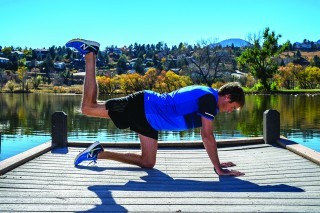
Photo: James Carney
Also called a bent-leg kickback, donkey kicks don’t require any equipment and can be performed anywhere.
“This exercise is beneficial for runners because stronger glute muscles can provide athletes with increased speed and agility,” says Dr. Bryce McManus, DC, MS, CCSP, of Guilford, Conn.
How to do it:
Step 1: Get onto your hands and knees and engage your deep core muscles.
Step 2: Kick one of your legs backward (like a donkey), extending it all the way out before returning to the starting position. Point your toes until they’re parallel to the ceiling when your leg is fully extended. Keep the core engaged the entire time, using your glutes to bring your leg back and forth. Maintain a flat back and keep everything still but the kicking leg. Slow, controlled movements will provide the most benefit. McManus recommends performing 10–12 reps for each leg.
“If you notice your back arching or leg drifting, stop the exercise. If you find being on your knees to be painful, try performing the exercise on padding such as a folded-over yoga mat,” McManus advises.
RELATED:
—6 Exercises to Work Your Glutes
—Getting the Most Out of Your Glutes
—The 4 Best Strength Training Exercises for Runners
The post How Donkey Kicks Strengthen Your Glutes appeared first on Competitor.com.
Running Tech Buzz: Timex Ironman One GPS+
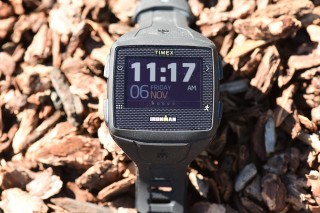
Photo: Adam Elder
This burly color GPS watch with a comfortable smaller wrist wrap is a great value for packing easily configurable stats and intervals, Bluetooth sensor capability and a 4GB music player. Stay connected via a built-in AT&T mobile network connection for two-way email (including canned responses), live tracking by designated Angels and SOS messages. Easily readable in bright sunlight, its spacious look and feel, a touch cartoonish, reminded us of an old-school cell phone. We occasionally saw crashes in very low AT&T signal areas when starting and finishing a workout with Angel notifications enabled, and the tap vs. touch screen took some getting used to.
Breakdown
Next-Gen Tool
It’s a no-compromises GPS run watch and music player with a no-phone connection to AT&T’s mobile network. (The first year is free!)
Amazing Visibility
Sunlight-readable, large color touch- screen—plus simple, intuitive setup and operation.
Run Phone-Free
Stay connected and located for safety and race fun. Your “Angels” can be notified when you start and finish, and can track you along the way.
RELATED: Running Tech Buzz: adidas miCoach
The post Running Tech Buzz: Timex Ironman One GPS+ appeared first on Competitor.com.
The Running Mentalist: Oz Pearlman
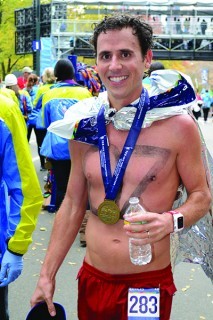
Oz Pearlman finished this year's New York City Marathon in 2:31:04.
Magic and mentalism was a natural fit for Oz Pearlman. Running wasn’t. The magic, and his passion for performing, were undeniable from the moment he saw it for the first time, through making card-trick demonstration videos in college, moonlighting as a magician after days working in the technology and services department at Merrill Lynch, and eventually captivating audiences from private parties and Presidents to recently finishing third on season 10 of “America’s Got Talent.” Oz (pronounced Ohz—the “o” is long) ran cross country for one season in high school and quit because “it was not my thing,” he says.
Given his 2:31:04 finish in the 2015 New York City Marathon, which he ran for the Susan G. Komen Breast Cancer Foundation, it’s apparent that the 33-year-old performer who lives in Manhattan’s West Village has now found his stride. (He’s won several marathons and has PRs of 2:23:52 for the marathon and 1:09:34 for the half marathon.)
When did you start running?
In 2004, my older sister decided to run the New York City Marathon. I ran 7 miles of it with her and decided I wanted to try a marathon too. So I ran the Philadelphia Marathon a month later. I finished [in 3:22:02], but it was not a pleasant experience. It was a death march, with lots of walking at the end.
RELATED: How Celebrities Fared in the 2015 New York City Marathon
Yet you kept running?
I’m a glutton for punishment! I read Dean Karnazes’ book “Ultramarathon Man,” and found it to be very inspiring. I kept running marathons, experimented with my fuel and training, and started running ultras and triathlons. [He also qualified for the Ironman World Championships in Kona, Hawaii.]
You’ve run the Leadville 100, Western States 100, Badwater 135 and the Spartathlon, among others. What is it about ultra-distance races for you?
In ultras there are levels of suffering that you don’t get in a marathon. You wonder, is this an injury or am I fatigued? Do I have low blood sugar or am I in a bumming mood? You can wing a marathon. There is no way in the world you are going to wing a 100-miler. I’ve found ultrarunners to be a very cool and welcoming lot. Ultras also have a different feel to them. Sure, we’re competing, but mostly with ourselves. Most of us are out to test our limits, make friends and enjoy the beautiful scenery.
Is there a connection between your work and running?
A lot of my bursts of creativity happen when I run. They are the best. I don’t listen to music, I just run with my thoughts. I come up with some really creative ideas. A run is where I love to try everything out. I pantomime and talk to myself, trying to coax out what I’ll do in my act.
What is your training like?
The majority of my training runs are at a comfortable pace, in the 7:30-8:30 range. I run five to six days a week, one run a day, no doubles and one tempo run per week. My tempo runs are all out—like racing. I take them really seriously. Peak training weeks are 110–120 miles. I think I recover better because most of my runs aren’t beating me up. I really listen to my body. I also got standing desks for work this year. They help tremendously with recovery, plus they help to strengthen my core.
Does diet factor into your running?
I’m not too rigorous about day-to-day moderation with food. Although I do focus on it when I train intensely. I avoid fried food and cut back on red meat. I’ll eat a lot of fruit, veggies, lean protein and cut back on alcohol. No beer equals true suffering. I like to lose weight before races. If I cut five, six, eight, 10 pounds before a marathon, I run faster. I lust over food before races. It’s a challenge, but only for the short period before a race.
What running goals keep you going?
Goals keep you sharp, inspired and passionate. My marathon speed goal is to run a sub-2:20. I want to put that on my tombstone because it’s a goal I never envisioned being possible. I want to improve my times and run the Ultra-Trail du Mont-Blanc one day and also the H.U.R.T. 100 in Hawaii.
RELATED: 36 Celebrities (and Other Notable People) Who Run
The post The Running Mentalist: Oz Pearlman appeared first on Competitor.com.
Does Extreme Ultrarunning Make Your Brain Shrink?

Photo: www.shutterstock.com
Running is full of health benefits, but is there a point where you can go way too far for way too long?
Scientists in Europe sought to answer that by closely monitoring 44 runners in the 2009 Trans Europe Foot Race, a grueling 4,500-kilometer run (about 2,700 miles) from Italy to Norway in 64 days (about 43 miles a day). According to New Scientist, “The team took a portable MRI scanner with them, and periodically scanned the legs, feet, heart, brains and cardiovascular systems of the athletes, as well as taking blood and urine samples.”
Granted, a 2,700-mile race is farther than almost any ultramarathon out there, but what scientists found was fascinating. Specifically, the runners’ brains shrunk by an average of 6 percent over the course of the race.
Lead researcher Uwe Schütz at the University Hospital of Ulm in Germany presented his study at the Radiological Society of North America annual meeting last week, according to New Scientist.
Why did their brains shrink? It’s hard to say. Extreme fatigue and undernourishment are obvious theories, but Schütz has another idea. He thinks it could be lack of stimulation from doing the same thing (staring at the road and trail in front of you) for 64 straight days.
The good news? It’s not permanent.
“It is hard to explain what’s going on,” says Schütz told New Scientist. “But we do see total recovery after six months.”
Schütz told New Scientist that people who run normal marathons won’t experience the same effects.
MORE: New Scientist
The post Does Extreme Ultrarunning Make Your Brain Shrink? appeared first on Competitor.com.
Shoe Of The Week: Brooks Adrenaline ASR 12 GTX
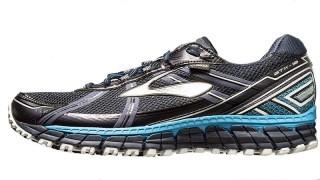
The Adrenaline ASR GTX is an especially versatile shoe for winter running, especially if you often find yourself running in snow, slush and sub-freezing temperatures. Photo: Scott Draper
Always getting better with age, this long-popular hybrid trail shoe with a road-shoe feel is also available in a Gore-Tex version for foul-weather running. The Adrenaline ASR’s mid-foot stability, ample cushioning and smooth ride make it a pleasure to run in on smooth dirt and less-than-technical terrain—including roads when necessary. Updated from the previous version of this popular shoe is a segmented crash pad (all that toothy rubber near the back of the shoe), which allows a more fluid ride than in past iterations of the Adrenaline ASR. The outsole has also been updated to better handle sloppy trails. Testers didn’t find it the most dynamic or agile shoe on technical trails, likely due to its road-shoe profile and plentiful cushioning. But it was lauded for serving up a soft and smooth ride. The Gore-Tex weather-proofing adds to the versatility of this winter shoe—wear it on sloppy road runs as well as off-road. In addition to keeping your feet dry, it will also help keep your feet warm on frigid days. This shoe is cut low around the ankle collar, which means zero irritation. If you’re a neutral runner, this shoe’s structure might feel like overkill or just too much shoe, although it won’t be at all noticeable running through slush and snow drifts.
This shoe is for you if … you need stability in a very versatile shoe that’s built for winter weather.
Price: $150
Weights: 11.8 oz. (men’s); 9.9 oz. (women’s)
Heel-Toe Offset: 12mm; 32mm (heel), 20mm (forefoot)
RELATED: Shoe of the Week—Saucony Xodus 6.0
RELATED: 9 Great Waterproof Shoes for Winter Running
The post Shoe Of The Week: Brooks Adrenaline ASR 12 GTX appeared first on Competitor.com.
Dallas Marathon and its Star-Studded Relay to Be Streamed Live
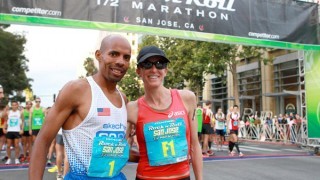
Deena Kastor and Meb Keflezighi are among the big names who will be in Dallas. Photo: PhotoRun.net
The Dallas Marathon made headlines last week when it announced that several of American distance running’s biggest stars would be on hand to run a special “Duo to Rio Relay” during the race this Sunday.
For those needing a running fix, WFAA-TV will televise the race starting at 8 a.m. Central on Sunday. Three hours of coverage will be streamed live on WFAA.com.
The broadcast will feature coverage of both the Duo to Rio Relay and the marathon itself, as well as the Pro Relay Challenge, which partners an additional six elite American runners with each of Dallas’ professional sports franchises in a competitive relay race.
The Duo to Rio Relay will feature several of the biggest names in U.S. running, most of which will be participating in the U.S. Olympic Trials marathon in about two months. The relay is set up for a male to run 13.1 miles and hand off to a female to run the second half. The pairings are:
Abdi Abdirahman and Deena Kastor
Sam Chelanga and Molly Huddle
Meb Keflezighi and Becky Wade
Luke Puskedra and Annie Bersagel
Jared Ward and Desiree Linden
Three-time Olympian Dathan Ritzenhein was slated to compete, but has withdrawn with a nagging bursitis issue in his hip. “I’ve been trying to get it under control and just get it completely 100 percent gone,” Ritzenhein told MLive.com.
The post Dallas Marathon and its Star-Studded Relay to Be Streamed Live appeared first on Competitor.com.
Bucket List: 13 Must-Do Half Marathons in the U.S.
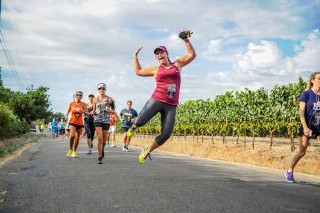
More than 2 million runners finished a half marathon in the U.S. in 2014, a stunning figure that quadrupled half marathon participation from just 15 years earlier. Those 2 million had about 2,200 half marathon races to choose from across the country, with participation numbers at those races ranging from a few hundred to more than 25,000.
RELATED: 13.1 Tips for Your Next Half Marathon
So how do you take 2,200 races and pick 13 as “bucket list” half marathons? We weighed several factors—popularity, history, scenery, competitiveness and uniqueness—to put together the ultimate list of half marathons you need to run. They are all over the country—from Vermont to Florida to Indiana to Hawaii—and bring something to the table that’s hard to replicate.
Here’s our list. How many have you checked off?
RELATED: 15 Bucket-List Marathons in the United States
Photo Gallery
1 of {count}
Back to Start
View Larger Image

NYC Half
It’s a relatively new race (starting in 2006), but the NYC Half has quickly become one of the most in-demand half marathons in the country. Unlike the five-borough NYC Marathon, the NYC Half is entirely in Manhattan. It starts with the famous Central Park loop before heading toward the Hudson River and then taking runners down to lower Manhattan with a finish on Wall Street. The race is each March and also has a sparkling elite field. Photo: PhotoRun.net
View Larger Image

Nike Women's Half
One of the few half marathons to use a lottery due to excessive demand, neither a pricey entry fee nor a tough course stops thousands from wanting in to this October race in San Francisco. The perks? Besides a tour of the beautiful Bay Area, the finish line “medal”—a Tiffany necklace—is one of the most popular in running.
View Larger Image
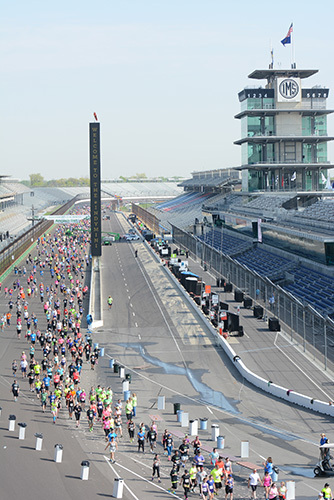
500 Festival Mini-Marathon
This popular race in Indianapolis is consistently one of the largest half marathons in the country, with more than 25,000 finishers. It’s known (besides its size) for the 2.5-mile loop around the Indianapolis Motor Speedway track from miles 6-8.
View Larger Image

Rock 'n' Roll Las Vegas
A chance to run on the Las Vegas Strip at night is one you cannot miss. It is the only time the Strip closes for runners, and the event turns into a part-race, part-party. Truly a one-of-a-kind event. It takes place annually in November.
View Larger Image

Covered Bridges Half Marathon
Dubbed “The Best 13.1 miles in New England,” this 25-year-old race in Vermont caps the field at 2,300 and is famous for the covered bridges participants run through. The non-profit race donates more than $50,000 a year to various youth causes.
View Larger Image

La Jolla Half Marathon
An incredible point-to-point course—but not an easy one. The April race starts at the Del Mar Fairgrounds and takes runners south along the Pacific coastline with the finish line near La Jolla Cove. It’s 13.1 miles of San Diego’s most stunning coastline, but it comes with several challenging hills so train accordingly!
View Larger Image

Brooklyn Half Marathon
This is one of the New York Road Runners' most popular races, taking runners from the Brooklyn Museum to the famous Coney Island boardwalk. It takes place each year in May. Photo: Courtesy of NYRR
View Larger Image

The Hapalua
Starting and finishing in Waikiki and running along the Oahu coastline and into downtown Honolulu, this April race has been dubbed “Hawaii’s Half Marathon.” Running vacation, anyone?
View Larger Image

Napa to Sonoma Wine Country Half Marathon
A summertime race in the popular California destination, this half marathon features a fast and scenic course starting at Cuvaison Carneros Winery and finishing in historic Sonoma Plaza in front of City Hall. Race organizers make a weekend out of it—besides the race, a welcome reception (at a winery, of course), a pre-race dinner and a wine & music festival are also offered. You may also bump into an elite runner—Ryan Hall and Magdalena Boulet are just a couple of past participants.
View Larger Image

Rock 'n' Roll Philadelphia
A fast race through one of America’s most historic cities, runners race along the scenic Schuylkill River, finishing at the Philadelphia Museum of Art (near the Rocky Steps!). The race is typically in September. Photo: PhotoRun.net
View Larger Image

BAA Half Marathon
This October race attracts more than 6,000 runners to Boston, and they get a great tour of the city's favorite running spots. The course winds along Boston’s famed Emerald Necklace, finishing at the White Stadium track in Franklin Park.
View Larger Image

Key West Half Marathon
A classic destination race, runners race through Old Town and the waterfront areas of Key West in this point-to-point, relatively flat race in the Florida vacation spot. The race takes place annually in January.
View Larger Image

Kentucky Derby Festival miniMarathon
The “miniMarathon” takes place in Louisville the weekend before the iconic horse race. Of course, you can’t have a Kentucky Derby Festival race without runners seeing Churchill Downs, and this race visits the historic site at mile 8. Photo: Marvin Young/KDF.
Related Galleries

The 10 Largest Half Marathons in the U.S.
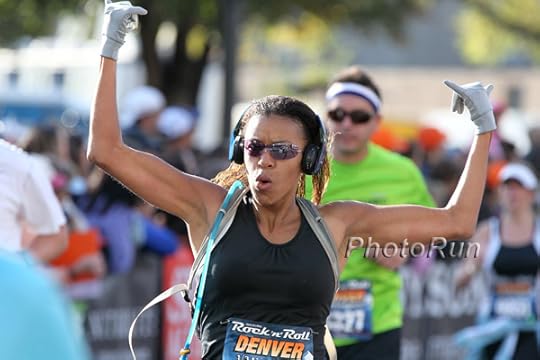
Rock ‘N’ Roll Marathon Transforms Denver

2010 Country Music Marathon Photo Gallery

2010 Rock ‘n’ Roll Dallas Half Marathon Photo Gallery

More Galleries
The post Bucket List: 13 Must-Do Half Marathons in the U.S. appeared first on Competitor.com.
December 9, 2015
Rock ‘n’ Roll Marathon Series Adds Third Mexico Race

Photo: Shutterstock.com
The Rock ‘n’ Roll Marathon Series is heading to another Mexican city in 2016.
The Rock ‘n’ Roll Querétaro Marathon and 1/2 is the latest addition to the race schedule. Formerly the Querétaro Marathon, the race will take place on Oct. 2, 2016 and be the first full marathon the series holds in Mexico. It will also have half-marathon and 10K options.
Rock ‘n’ Roll first went into Mexico in 2015 with Rock ‘n’ Roll Mexico City in March and Rock ‘n’ Roll Merida in October. Both were nighttime half marathons.
RELATED: Photos: Rock ‘n’ Roll Mexico City
“We’ve seen a lot of success with our inaugural events in Mexico City and Merida this year, and knew it was the right opportunity to expand into another city in Mexico,” said Shauna Buffington, vice president of global marketing for the Rock ‘n’ Roll Marathon Series. “Querétaro is a charming city that is rich in history and culture, and will be a great destination for runners to experience on foot. Our continued partnership with Asdeporte, a world-class event operator, will allow us to operate another seamless event in Mexico that showcases all that Querétaro has to offer.”
Querétaro is located in north-central Mexico, about 130 miles northwest of Mexico City. It has a metropolitan area of 1 million residents.
Presale entries and special pricing is available through December 16th, after which registration will then close and reopen in January. Presale pricing is $45 for the marathon and half-marathon and $30 for the 10K. You can register here.
The post Rock ‘n’ Roll Marathon Series Adds Third Mexico Race appeared first on Competitor.com.
Ryan Hall's Blog
- Ryan Hall's profile
- 21 followers



